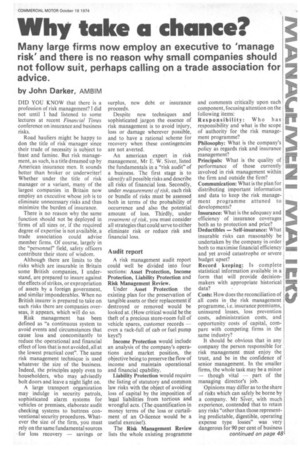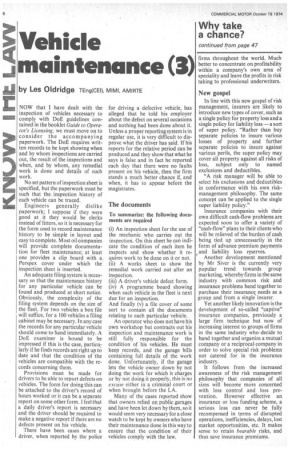Why take a chance?
Page 49

Page 50

If you've noticed an error in this article please click here to report it so we can fix it.
Many large firms now employ an executive to 'manage risk' and there is no reason why small companies should not follow suit, perhaps calling on a trade association for advice.
by John Darker, AMB1M DID YOU KNOW that there is a profession of risk management? I did not until I had listened to some lectures at recent Financial TiffiCS conference on insurance and business risks.
Road hauliers might be happy to don the title of risk manager since their trade of necessity is subject to feast and famine. But risk management, as such, is a title dreamed up by American insurance men. It sounds better than broker or underwriter! Whether under the title of risk manager or a variant, many of the largest companies in Britain now employ an executive whose job is to eliminate unnecessary risks and thus minimize the burden of insurance.
There is no reason why the same function should not be deployed in firms of all sizes or, if the required degree of expertise is not available, a trade association could advise member firms. Of course, largely in the "personnel" field, safety officers contribute their store of wisdom.
Although there are limits to the risks which are insurable in Britain some British companies, I understand, are prepared to insure against the effects of strikes, or expropriation of assets by a foreign government, and similar imponderables. When no British insurer is prepared to take on such risks there are companies overseas, it appears, which will do so.
Risk management has been defined as "a continuous system to avoid events and circumstances that cause loss and concomitantly to reduce the operational and financial effect of loss that is not avoided, all at the lowest practical cost". The same risk management technique is used whatever the . size of the business. Indeed, the principles apply even to householders, Who may advisedly bolt doors and leave a night light on.
A large transport organization may indulge in security patrols, sophisticated alarm systems for vehicles or premises, elaborate audit checking systems to buttress conventional security procedures. Whatever the size of the firm, you must rely on the same fundamental sources for loss recovery — savings or surplus, new debt or insurance proceeds.
Despite new techniques and sophisticated jargon the essence of risk management is to avoid injury, loss or damage wherever possible, and to have a rational scheme for recovery when these contingencies are not averted.
An american expert in risk management, Mr E. W. Siver, listed the fundamentals in a "risk audit" of a business. The first stage is to identify all possible risks and describe all risks of financial loss. Secondly, under measurement of risk, each risk or bundle of risks must be assessed both in terms of the probability of occurrence and also the potential amount of loss. Thirdly, under treatment of risk, you must consider all strategies that could serve to either eliminate risk or reduce risk and financial loss.
Audit report
A risk management audit report could well be divided into four sections: Asset Protection, Income Protection, Liability Protection and Risk Management Review.
Under Asset Protection the existing plan for the preservation of tangible assets or their replacement if destroyed or removed would be looked at. (How critical would be the theft of a precious store-room full of vehicle spares, customer records — even a rack-full of cab or fuel pump keys?) Income Protection would include an analysis of the cornpany's operations and market position, the objective being to preserve the flow of income and maintain operational and financial cpability. Liability Protection would require the listing of statutory and common law risks with the object of avoiding loss of capital by the imposition of legal liabilities from tortious and wrongful acts. (The quantification in money terms of the loss or curtailment of an 0-licence would be a useful exercise!).
The Risk Management Review lists the whole existing programme and comments critically upon each component, focusing attention on the following items: Responsibility: Who has 1 1110 responsibility and what is the scope of authority for the risk management programme?
Philosophy: What is the company's policy as regards risk and insurance management? Principals: What is the quality of TI 11111
_
performance of those currently involved in risk management within the firm and outside the firm?
Communication: What is the plan for distributing important information and data to keep the risk management programme attuned to developments?
Insurance: What is the adequacy and efficiency of insurance coverages both as to protection and price? Deductibles — Self-insurance: What insurable risks can reasonably be undertaken by the company in order both to maximise financial efficiency and yet avoid catastrophe or severe budget upset?
Record keeping: Is complete statistical information available in a form that will provide decisionmakers with appropriate historical data?
Costs: How does the reconciliation of all costs in the risk management programme, i.e. insurance premiums, uninsured losses, loss prevention costs, administration costs, and opportunity costs of capital, compare with competing firms in the same industry?
It should be obvious that in any company the person responsible for risk management must enjoy the trust, and be in the confidence of senior management. In the smaller firms, the whole task may be a minor — though vital — part of the managing director's job.
Opinions may differ as to the share of risks which can safely be borne by a company. Mr Slyer, with much experience, contended that to retain any risks "other than those representing predictable, digestible, operating expense type losses" was very dangerous for 90 per cent of business firms throughout the world. Much better to concentrate on profitability within a company's own area of speciality and leave the profits in risk taking to professional underwriters.
New gospel
In line with this new gospel of risk management, insurers are likely to introduce new types of cover, such as a single policy for property loss and a single policy for liability loss — a sort of super policy. "Rather than buy separate policies to insure various losses of property and further separate policies to insure against various perils, the super policy may cover all property against all risks of loss, subject only to named exclusions and deductibles.
"A risk manager will be able to select his exclusions and deductibles in conformance with his own riskmanagement philosophy. The same concept can be applied to the single super liability policy."
Insurance companies with their own difficult cash-flow problems are expected soon to offer a variety of "cash-flow" plans to their clients who will be relieved of the burden of cash being tied up unnecessarily in the form of advance premium payments and liability loss reserves.
Another development mentioned by Mr Slyer is the currently very popular trend towards group marketing, whereby firms in the same industry with common risk and insurance problems band together to purchase their insurance needs as a group and from a single insurer.
Yet another likely innovation is the development of so-called "captive" insurance companies, previously a large firm technique but now of increasing interest to groups of firms in the same industry who decide to band together and organize a mutual company or a reciprocal company in order to solve special risk problems not catered for in the insurance industry.
It follows from the increased awareness of the risk management philosophy that companies of all sizes will become more concerned with loss control and loss prevention. However effective an insurance or loss funding scheme, a serious loss can never be fully recompensed in terms of disrupted operations, inefficiencies, delays, lost market opportunities, etc. It makes sense to retain bearable risks, and thus save insurance premiums.




































































































